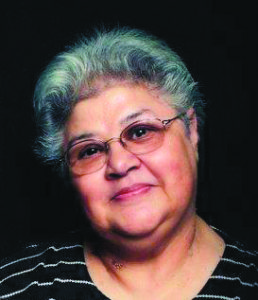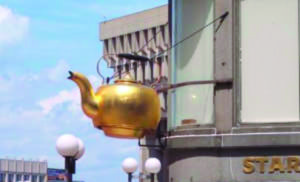

As many of our readers know, my husband Frank was “born in South Boston in a 3-decker flat;” and after we married and had four children, we moved to Wrentham, Massachusetts and, of course, visited Boston’s downtown area on many occasions. Boston’s colorful history is the stuff of books and legends. Many of the city’s landmarks are well known. There are the stops along the Freedom Trail, Paul Revere’s house, The Old North Church, The Bunker Hill Monument, and the USS Constitution, just to name a few.
Then, there is the Golden Teapot on Court Street that hangs above what is now a Starbucks coffee shop.
At Court & Tremont Streets (near Government Center) hangs the giant tea kettle “sign” of the old Oriental Tea Company. This huge tea pot was manufactured in 1873 by a company called Hicks & Badger. The sign spent many years on the south side of Scollay Square, and was moved to varying locations in the area as buildings were torn down.
“One of the reasons they hung that tea kettle up there, and the reasons a butcher would hang a picture of a cow, or a baker would hang a big representation of a pie, is because Boston was becoming a city of immigrants. Many of those immigrants didn’t speak English and so for the purveyors of their wares to tell people what they were shopping for, they would hang representations, and so the tea kettle, for generations of Bostonians, told them where they could buy some of the finest tea in Boston,” according to Dave Kruh, a Boston history buff who has written books about what used to be called Boston’s West End.
The tea pot was a famous tourist attraction for many years due, in large part, to a clever publicity stunt. On January 1, 1875, a contest was held to guess the capacity of the kettle. Boston’s Sealer of Weights & Measures officially measured it.
At noon, more than 10,000 spectators filled the square that day. Eight boys and a tall man had concealed themselves inside the kettle and appeared before measuring started, building excitement for the event. The 13,000 guesses were quickly organized and sorted.
Each measure poured into the kettle was carefully checked by the city’s inspector. A judge was present to observe the process to ensure the contest was fair. A large blackboard was updated after each measure, and it took more than an hour to fill the pot. At 1:05 pm, the closest guess was announced, and a great cheer came from the crowd.
The tea kettle’s capacity is two hundred and twenty seven gallons, two quarts, one pint, and three gills (a gill = 4 fluid ounces). Eight people that participated in the contest had guessed to within 3 gills of the above quantity, and were declared winners, each receiving as their prize one-eighth of a chest of tea, or about 5 pounds.
The tea kettle contains an apparatus within it that produces steam, and in winter it resembles a giant steaming pot of tea. The kettle is an excellent advertising tool, having outlived the Oriental Tea Company by many years.
Next time you’re in Boston, be sure to check out the Giant Tea Kettle, at Court and Tremont Streets, near Government Center.
Sources: www.celebrateboston.com; www.boston.com; www.boston.cbslocal.com
No Comments
Leave a comment Cancel